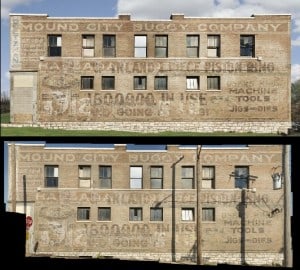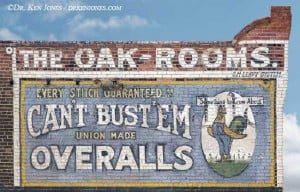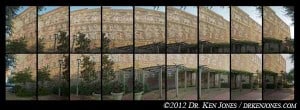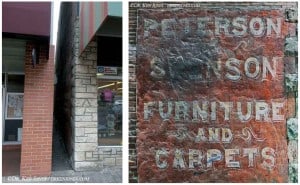18 Apr 2012
Dr Ken Jones’ mosaic technique for ghostsigns photography
Dr Jones believes that the large extent of existing ghostsigns photography would render his work meaningless unless he was doing something different, adding “something unique to the mix”. Here is a brief account of how he goes about this. (A more detailed exposition can be found on his methods page).
Using what he describes as a ‘mosaic’ approach, Dr Jones shoots many (up to 200) high resolution images of the signs from different angles. He has developed a number of techniques to do this, including the use of DIY equipment to capture signs in high places or down narrow alleys, even as narrow as the one pictured below, beside his resulting mosaic.
The mosaic technique allows different parts of the final image to be represented by different original photos. It facilitates the elimination of awkward trees, poles and other items obstructing the sign, as seen in the before and after below.

The technique does however require significant post-shoot organisation and technical work with a number of software packages to collate the material and produce various cuts of the final image. These are then assembled in photoshop, with some minor colour tweaking and backgrounds added as the final steps. This addition of backgrounds is necessary because the mosaic technique would otherwise result in warped backgrounds due to the shifting of angles in the original set of images to create the ‘straight on’ effect. On this he says, “I photograph appropriate backgrounds for the region of the country where the sign is located … no palm trees behind signs in Boston”.
The final results of these efforts are excellent archival records of ghostsigns from all over the USA. It is clearly painstaking work, not least managing what currently stands at over 200,000 images of 3,000 signs, using over 20 terabytes of storage. I am sure that some would argue against removing the context that surrounds the signs in situ, but this misses the point of what he is trying to do. Much of the detail and craft that exists within the signs is obscured and his technique provides a specific focus on these aspects of the signs, removing anything that obscures the treatment of the object in isolation. In this sense there is a scientific dimension, working to ‘decontaminate’ the specimen before considering its essential properties.
Dr Jones is regularly finishing new signs and adding them to his finals page on the site and it is possible to order prints, although this will become formalised further later this year. There is a mapping component to his website which allows the signs to be filtered by state, with further filtering by product category also possible. I’ll sign off with some quotes from Dr Jones on a handful of ghostsigns topics.
The essential features of a good ghostsign:
“Authentic”; “Not too recent”; “Not restored or recreated”; “Contains something interesting or unique”; “Signs for long forgotten and quaint products”; “Signs with some social commentary unintentionally built in”.
“I have some exotic equipment – some so exotic my wife jokes I could easily end up either in the local newspaper or in the local jail.”
On the disappearance of ghostsigns:
“Before driving 1000 miles to see a sign, make sure it is there.”
On sign revealed by the destruction of adjacent buildings:
“Those signs are the ultimate prize for they reveal the best original color references and detail.”
On restoration:
“My personal feeling is that restoring ghost signs to their original colors is a bad thing. To me, an entire town begins to resemble a Disneyland-like recreation.”





